The Beyer-Bau in the test
Table of contents
Project data
| Titel | Title Tragwerksuntersuchungen im Beyer-Bau | The Beyer-Bau in the test Förderer | Funding Staatsbetrieb Sächsisches Immobilien- und Baumanagement, Niederlassung Dresden II, Sachgebiet Hochbau 2, Dresden Zeitraum | Period Seit 01.2017 (fortlaufend) Leiter | Project Manager Prof. Dr.-Ing. Dr.-Ing. E.h. Manfred Curbach (Institut für Massivbau, TU Dresden), Bearbeiter | Contributors Dipl.-Ing. (FH) Sabine Wellner, Dr.-Ing. Torsten Hampel, Versuchsdurchfühung | Test execution Tino Jänke, Maik Patricny, Andreas Thieme, Heiko Wachtel, Bernd Wehner |
Report in the annual report 2019
BEYER-BAU IN PROGRESS
The reconstruction of the Beyer-Bau is in full operation! In recent months, walls, floors and built-in components are being removed after a large number of component and material tests have been carried by the Otto-Mohr-Laboratory.
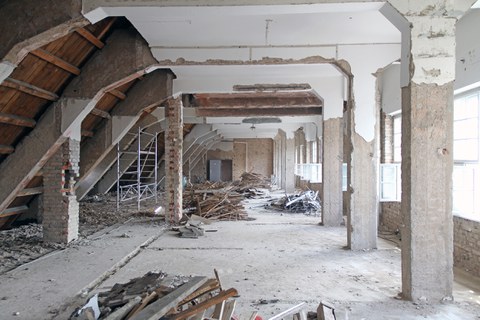
Construction work in progress
During the building phase, the Otto-Mohr-Laboratory has again determined experimentally the structural safety of components according to their intended use. Loading experiments were carried out on a beam and on ceiling constructions. On the basis of an individually developed measuring concept, the current state of the components were evaluated.
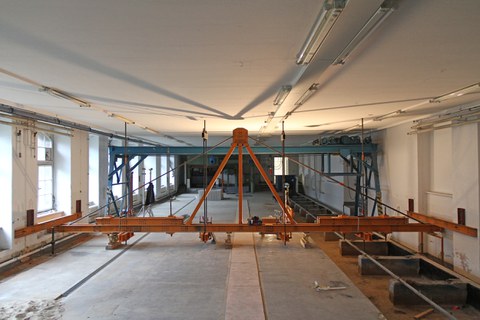
Support construction in the basement
The distributed load of 7.34 kN/m² for ceilings and 10.34 kN/m² for beams consists of dead and live load including partial safety factors. The load was combined via four individual loads via a carrier system and the force was controlled with a hydraulic cylinder, which was coupled with a load cell. The load-related deflections were measured with inductive position sensors (IWA). The maximum loads were achieved in all load cases without problems and without affecting the structure. There were only expected cracks but to a small extent. The crack widths remaining were in the tenth of a millimetre range after unloading. Damage or visual changes to the beam, the ceiling itself or the adjacent components were not observed.
In addition to the load tests, the material investigations were continued. Thus, the tensile strength of reinforcing steel from ceilings and beams, the carbonation depth and the chloride content of the concrete were determined from ceiling surfaces. In addition, the surface tensile strength of the concrete was determined for the upcoming concrete restoration.
Also, material investigations were carried out in the 40-meter high tower of the observatory. Such tests included the concrete compressive strength, carbonation depth and adhesive tensile tests
Recently, as part of the progressive renovation of the Beyer-Bau, a beam was strengthened by carbon reinforced concrete. This method is currently verified as an alternative to demolishing and rebuilding components. The aim is to preserve the historical existing construction and to enable an economic rehabilitation and strengthening of the structure.
Report in the annual report 2018
WEITERFÜHRUNG DER TRAGWERKSVERSUCHE IM BEYER-BAU
In 2018, the Otto Mohr Laboratory realized a variety of material and experimental load tests in preparation for the approaching renovation of the Beyer-Bau. Thus, for example, tests were conducted to explore the position and dimension of structures, rebar detection, adhesive tensile tests for determining the tensile strength of the concrete surface and various tests of steel and concrete.
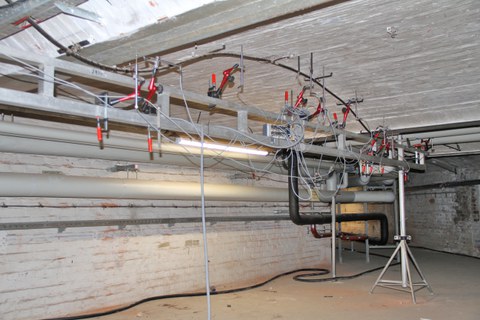
Messtechnikaufbau unter der Gewölbedecke im Ostflügel
Besides the material research and testing, experimental load tests were also carried out. Particular attention was paid at two typical well-chosen places of the vaulted ceilings in the cellar. For the upcoming renovation efforts, the effect of a moving load resulting from „a hand-moved and hand-controlled fork-lift as transport unity“ had to be investigated. In preparation of the tests, a load rate of 3 tons (self-weight 0.5 tons, plus a maximum additional load of 2.5 tons) was set. The characteristic values of the action had to be multiplied by a safety factor. Because of the load-distributing vault effect and the favourable load transfer, the test load was implemented as a concentrated load in the quarter of the vault. Thus, the most unfavourable load position should be shown and examined. The load was split into two load application points. The distance of those two points depended on the fork-lifts wheel distance of 1.2 m. The load application surface was chosen as a 20 x 20 cm rectangle. In the south wing, the load application occurred along the direction of the vault; in the east wing, crosswise to the direction of the vault.
Seven loading cycles, as well as 20-minute long loading intervals, were performed to evaluate the load-bearing behaviour of the vaults to cyclic loading. The maximum deflection during the experimental load test was in the tenth-millimetre range. Besides, no appreciable plastic deformations, spalling or masonry movements were determined. In summary, it can be concluded that the vaults have a load bearing capacity beyond the degree that is demanded.
Report in the annual report 2017
THE BEYER-BAU IN THE TEST
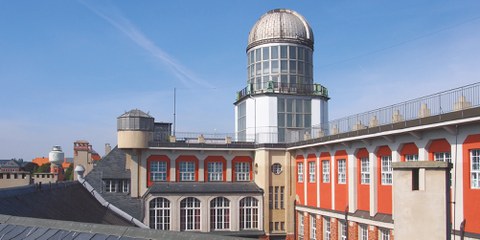
Beyer-Bau is a landmark of the TU Dresden
In the early 1900‘s, the number of students in Dresden had risen so much that the campus of the former ‘Technische Hochschule‘ had to be expanded. As a result, the area on which the main campus of the TU Dresden is located todaywas made available as a construction site. At that time, the building named today ‘Beyer-Bau‘ was planned and built on the Fritz-Förster-Platz. It was one of the first structures that were made of ferroconcrete in Dresden. The outer shape of the building is dominated by the 40-meter high tower of the observatory of the Geodetic Institute.
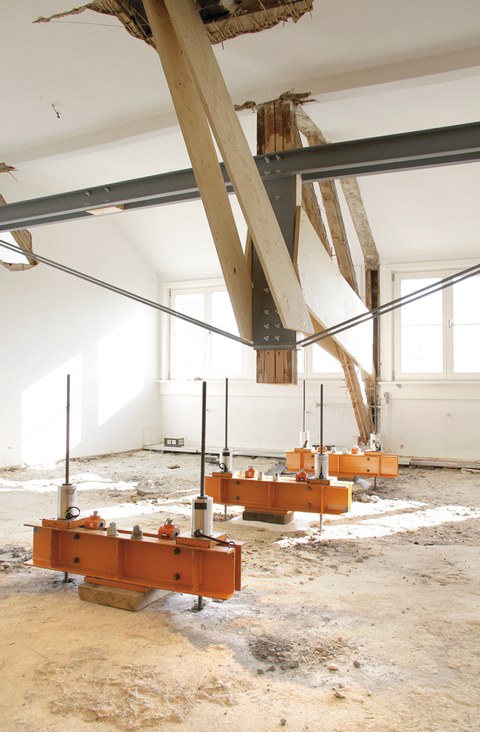
Loading device for testing a beam
In the meantime, the Beyer-Bau has gotten old. In August 2016, the building was vacated, so that a comprehensive renovation could take place. In December 2016, the first material samples were obtained. In one of the beams above the ground floor, one of four bars of the flexural tensile reinforcement was removed. It was a round steel bar with a diameter of about 30 mm, without ribs on the surface, as it was usual 100 years ago. At the beginning of 2017, two axial tensile tests were carried out on the two halves of the rebar, using a digital optical measuring system for deformation measurement. Both working lines were almost identical. At 356 N/ mm², the yield strength was reached. This value is significantly above the characteristic yield strength that was used for round steel bars atthe time. From a 1.5% elongation, a significant hardening of the steel was observed. The maximum stress was 565 N/mm²; the associated elongation 16.6%. At 30.5% elongation, the material failed at a tension of 453 N/mm². Thus, regarding strength and ductility, the material is not far from today’s requirements. Also, in 2017, two in situ load tests were carried out in two T-beams above the first and second floors. In both tests, the target loads were achieved in all load cases without any problems. Only a few cracks were noticeable, and they occurred as expected. After removal of the load, the remaining crack widths were in the tenth of a millimetre range. Damage or visual changes to the beams themselves or of the adjacent components were not observed. Currently, non-destructive testing is underway to locate the reinforcement at several joists in the building.
